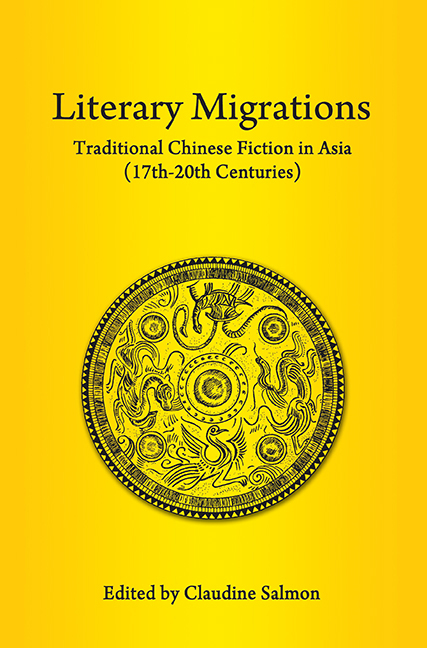Book contents
- Frontmatter
- Contents
- FOREWORD
- Dr Salmon as I Know her
- Preface to Reprint Edition
- Acknowledgements
- INTRODUCTION
- PART I KOREA AND JAPAN
- PART II MAINLAND NORTHEAST ASIA
- PART III MAINLAND SOUTHEAST ASIA
- PART IV INSULAR SOUTHEAST ASIA
- 10 A Note on Javanese Works Derived from Chinese Fiction
- 11 Malay Translations of Chinese Fiction in Indonesia
- 12 Writings in Romanized Malay by the Chinese of Malaya — A Preliminary Inquiry
- 13 Lie Sie Bin Yoe Tee Hoe — Six Malay/Indonesian Translations of a Chinese Tale
- 14 Liang Shanbo yu Zhu Yingtai — A Chinese Folk Romance in Java and Bali
- 15 Translations of Chinese Fiction into Makassarese
- 16 Sam Pek Eng Tay — A Chinese Love Story in Madurese
- 17 Post-war Kung Fu Novels in Indonesia — A Preliminary Survey
- Bibliography
- Author, story-teller and translator index
- Title index
- List of Plates
- Contributors
- Plate section
17 - Post-war Kung Fu Novels in Indonesia — A Preliminary Survey
from PART IV - INSULAR SOUTHEAST ASIA
Published online by Cambridge University Press: 21 October 2015
- Frontmatter
- Contents
- FOREWORD
- Dr Salmon as I Know her
- Preface to Reprint Edition
- Acknowledgements
- INTRODUCTION
- PART I KOREA AND JAPAN
- PART II MAINLAND NORTHEAST ASIA
- PART III MAINLAND SOUTHEAST ASIA
- PART IV INSULAR SOUTHEAST ASIA
- 10 A Note on Javanese Works Derived from Chinese Fiction
- 11 Malay Translations of Chinese Fiction in Indonesia
- 12 Writings in Romanized Malay by the Chinese of Malaya — A Preliminary Inquiry
- 13 Lie Sie Bin Yoe Tee Hoe — Six Malay/Indonesian Translations of a Chinese Tale
- 14 Liang Shanbo yu Zhu Yingtai — A Chinese Folk Romance in Java and Bali
- 15 Translations of Chinese Fiction into Makassarese
- 16 Sam Pek Eng Tay — A Chinese Love Story in Madurese
- 17 Post-war Kung Fu Novels in Indonesia — A Preliminary Survey
- Bibliography
- Author, story-teller and translator index
- Title index
- List of Plates
- Contributors
- Plate section
Summary
“Where there are wells and water, there are ethnic Chinese.” This was a common Chinese saying. Perhaps one can change it to the following: “Where there are Chinese, there are kung fu novels.” Before discussing kung fu novels in Indonesia (or cerita silat as they are popularly called), it is helpful to define briefly the Indonesian Chinese communities.
The ethnic Chinese can be divided into peranakan and totok communities. The former has lost an active command of the Chinese language while the latter still speaks Chinese. Peranakan Chinese have been in Indonesia for generations. Before World War II, those who were well-to-do were likely to have received Dutch education. The poor attended the Chinese schools (Tiong Hoa Hwee Koan), but generally used Malay or a local language as the medium of communication. Peranakan Chinese were primarily decendants of Hokkien. Therefore there were Hokkien words in their Malay, known as Bahasa Melayu-Tionghoa or Peranakan Malay. Even their names were also pronounced and hence spelt in Hokkien. As for the totoks, they were more recent migrants. Therefore culturally they are still Chinese. Nonetheless, those totok children who were born in Java have been Peranakanized, due to the local conditions which discouraged the development of a totok society. In the mid-1960s, all Chinese-medium schools were closed and since then this Peranakanization process has become more rapid than ever.
Long before World War II, Peranakan Chinese had started reading kung fu novels in Malay. These novels were either the translations or adaptations of yanyi xiaoshuo (historical romances), or the works of pre-war kung fu writers such as Huanzhu louzhu, Pingjiang buxiao sheng and Bai Yu etc. The popularity of the kung fu novels can also be seen in the publication of a kung fu novel magazine called Kiam Hiap (Jianxia) or “Sword-fighters” in West Java which lasted for five years (1931–35). Totok Chinese, on the other hand, read the novels in their original.
- Type
- Chapter
- Information
- Literary MigrationsTraditional Chinese Fiction in Asia (17th–20th Centuries), pp. 393 - 414Publisher: ISEAS–Yusof Ishak InstitutePrint publication year: 2013

